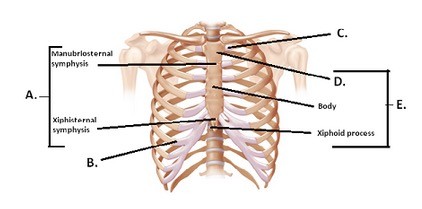 The figure illustrates the joints and bones of the rib cage. What does "E" represent?
The figure illustrates the joints and bones of the rib cage. What does "E" represent?
A. Manubrium
B. Sternal symphyses
C. Costochondral joint
D. Sternum
E. Sternocostal synchrondrosis
Answer: D
You might also like to view...
Matching
A) Lumbar vertebrae B) Axis C) Atlas D) Coccyx E) Thoracic vertebrae 23) These bones have the thickest body (centrum) with short blunt spinous processes. 24) The fused rudimentary tailbone. 25) The bone that articulates with the occipital condyles. 26) These bones have articular facets for the ribs. 27) Allows the head to nod "yes." 28) Allows the head to shake "no."
Grooves on the external surface of the heart that divide the right and left ventricles include the
A) lateral sulcus. B) interventricular septum. C) coronary fissure. D) anterior interventricular sulcus. E) atrioventricular sulcus.
Ventral means above
Indicate whether the statement is true or false
Define monogastric
What will be an ideal response?